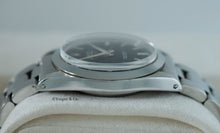
Rolex. A Stainless Steel Anti-Magnetic Wristwatch
Model: Milgauss
Reference: 1019
Circa: 1979
Cal. 1580 automatic movement, 26 jewels, black matte dial, applied baton numerals with luminous accents, luminous hands, outer minute divisions, center seconds with red arrow tip, circular stainless steel case, blank polished bezel, screw down crown, screw back, stainless steel Rolex Oyster bracelet and deployant clasp, case, dial, and movement signed
38mm.
More about Rolex:
In the 1950s, Rolex was approached by CERN (the Conseil Europeen pour la Recherche Nucleaire) to develop a wristwatch that could be exposed to strong magnetic fields and still function. At the time, anti-magnetic wristwatches existed, but none could withstand the strength of the magnetic fields at CERN, which were up to 70,000 amperes/meter – 1,000 gauss (or mille gauss). At such an intense level of electroganetic energy, the movement of most watches would simply stop running - a normal watch could only withstand between 70 and 90 Gauss.
Rolex developed an anti-magnetic watch for physicists using the principle of a “Faraday Cage”. This particular development came from physicist Michael Faraday, who in 1863 built a room that was coated with metal foil. He then produced high-voltage discharges against the outside of the room, and used an electroscope to measure the electrical charge on the inside of the room. The metal foil prevented any excessive charges from entering the room. Rolex used this principle to place the watch movement in an iron inner case, thus protecting it from magnetic fields. The resulting anti-magnetic watch was the Milgauss reference 6541.
In 1966, Rolex redesigned the Milgauss and launched the reference 1019. Unlike the 6541, it featured a blank polished bezel, and was available with either a silvered dial or a black dial. The 1019 model also featured a newer movement, the caliber 1580. The model was produced through 1990, and was only available in stainless steel.
The Milgauss model is appreciated by collectors for being the last Rolex “tool” watch designed for a specific activity and for use by a specific group of clients. Nevertheless, it’s simplistic design and functionality is what makes it so appealing today. The present watch is a mint example of this celebrated and sought-after Milgauss reference.













